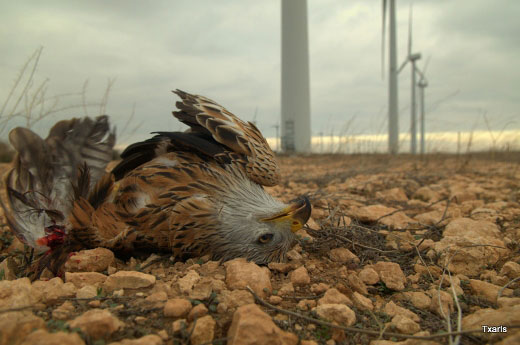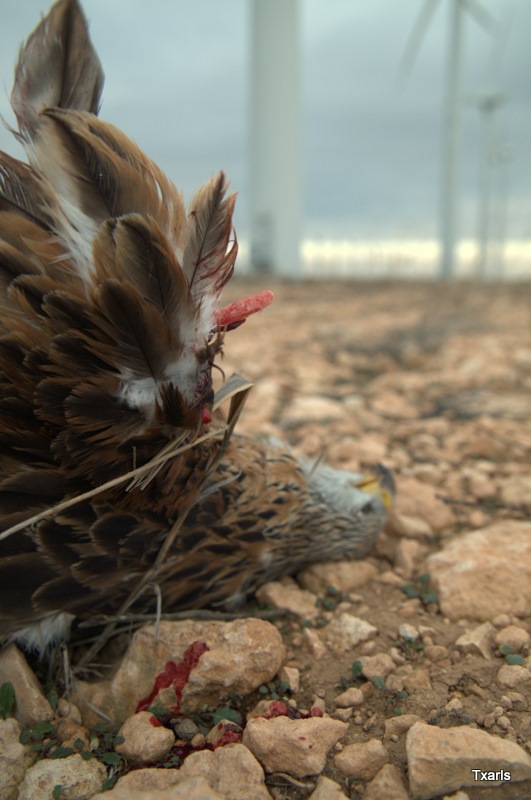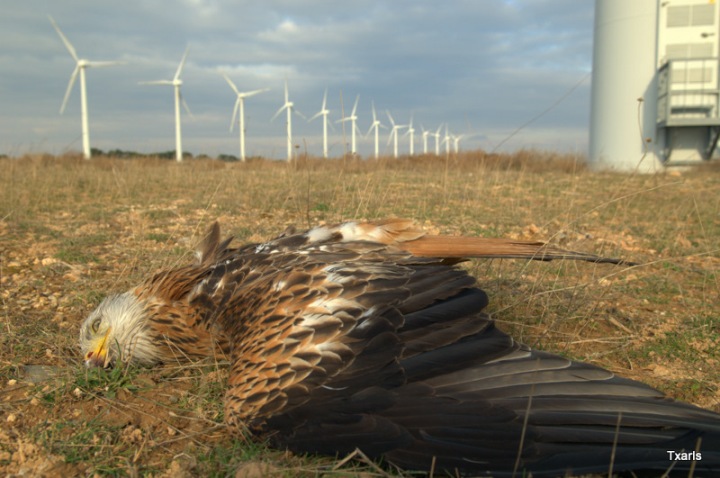| The Red Kite : decimated by wind farms in the EU |
(4282) |
| THE RSPB AND THE EUROPEAN COMMISSION SHOW CONTEMPT FOR GENUINE CONSERVATIONISTS |
The EU Red Kite Action Plan drafted by the RSPB fails to address the problem. On Oct. 28th 2009, we denounced this irresponsible policy with the European Commission. Our request, which incorporates proposed solutions, was simply ignored. A follow-up letter, sent on Jan. 30th 2010, has remained unanswered.
Recent news further evidence the cover-up of significant bird mortality at wind farms, affecting rare and emblematic species. |
.
.

Above picture : Two Red Kites were found agonising at the foot of wind turbines in Navarre last Sunday, Feb 14th, 2010. Says GURELUR´s spokesman : on Sundays, there are no employees to check the grounds and to hide bird carcasses away (1). This malicious behaviour had been related by several ornithologists already, and by the Spanish Ornithological Society (4). It may be systematic, and could be the result of specific instructions from wind farm operators. The unlawful removal of carcasses without reporting has the effect of hiding from the public the bird massacres that are actually taking place at wind farms around the world.
Courtesy of the ecological association GURELUR, from the Navarre region in Spain - www.gurelur.org
The fate of the Red Kite, a mostly European species also present in northwest Africa, had been discussed at the International Red Kite Symposium on Oct. 17-18th, 2009. We relate below what was learned then, and the disdain shown by the RSPB and the European Commission about taking any corrective steps.
There is abundant evidence that raptors in general, and Red Kites in particular, are at risk when wind turbines are erected within their breeding territories, or in areas surrounding their roosting places. See : LINK to Power Point presentation on Red Kites and Wind Farms
A study by ornithologist Ubbo Mammen, commissioned by the German government, confirms this. So does one realised in France by EPOB. In the circumstances, adopting a wait-and-see attitude regarding the wind farm threat on the already declining red kite population would be reckless. For once the Red Kite’s habitat all over Europe is sprinkled with wind farms acting as population sinks, it will be too late to do anything about it.

Above picture : close-up on the wound. Courtesy of the ecological association GURELUR, from the Navarre region in Spain - www.gurelur.org
A major flaw in the present system is that environmental impact studies are being financed and controlled by the windfarm developers themselves: it is a "fox-in-charge-of-the-hen-house" situation. It is unacceptable, and this biodiversity-threatening aberration must be addressed urgently.
The absence of cumulative impact studies for wind farms at national and European levels is another serious deficiency in the EU conservation policy of the Red Kite.
To help save this raptor from the growing threat of death by collision with wind turbines, we make the following proposals :
1) - The Red Kite EU Action Plan should call for a minimum setback of 3 km between wind turbines and red kite nests or roosting places. The minimum 1 km setback recommended by Ubbo Mammen only protects about 50% of breeding red kite flights, much less in lower density regions. Actually, 5 or 6 km would be best.
2) - An interim census of the Red Kite population should be conducted in Germany, Spain and Italy.
- Germany : because its red kite population may have come down since the 2004 census.
- Spain : because we have evidence of a sharp decline in some regions.
- Italy : because of the communications from Mr Allavena (see my Power Point presentation above and the link to his alarming discoveries).
An interim census is not necessary in the case of France: we already know from a recent LPO study (2008) that the red kite population has decreased significantly (20-30% since 2002). I think some of the decline may be explained by the fact that a number of red kites that breed in France spend the winter in Spain, where poison and numerous wind farms take a heavier toll.

Above picture : the other Red Kite found in Navarre last Sunday. Courtesy of the ecological association GURELUR, from the Navarre region in Spain - www.gurelur.org
It has been argued that, in some countries, the Red Kite is in expansion. But this responds to specific situations, such as reintroduction efforts and/or the reclaiming of ancient red kite habitats where food and nesting site availability, and newly enforced protection laws, permit a "reconquest" of lost territory (UK and Switzerland for instance). We are not familiar with the case of Southern Sweden. One delegate argued that global warming may be the cause of the recent red kite expansion into that country. However, supposing that the region was never used by red kites before, changes in land use and other factors such as dumps should be considered. But whatever the specificity of the case, expansions are all temporary in nature : once the (re)conquest of a territory is achieved, poison, persecution, electrocution, dump closures and newly built wind farms will be taking an unsustainable toll. Country-specific expansions are not, therefore, valid arguments for disregarding the wind farm threat, especially as in these countries wind farms are far from having reached their apex. What is happening in countries with established populations and an important wind farm deployment is much more indicative of what lies ahead.
Ornithology delegates from Germany, Italy, France and Spain, who spoke before I did at the International Red Kite Symposium of 17 - 18 oct 2009, stressed the risk that wind farms represent for the survival of the Red Kite. One of them, Ubbo Mammen, recommends a minimum setback of 1 km, and adds that 2 km would be more desirable (and possibly more in lower density areas). The RSPB delegates are the only ones who play down the risk, and take a wait-and-see attitude in their draft of the Red Kite EU Action Plan (on which they have a quasi-monopoly, it would seem). They base their policy on a single monitoring study : that of the Braes of Doune wind farm in Scotland, conducted by Natural Research Ltd.
But these consultants are not renowned for their objectivity. As a matter of fact, they enjoy an excellent relationship with the wind industry, from which they obtain many contracts. The industry is, obviously, very pleased with them. This doesn´t bode well for bird interests.
I have read some of their reports, and was neither impressed by their monitoring methods, nor by their disdain for the precautionary principle. So, what to make of the validity of their field observations, and of their conclusions ? In the circumstances, it would be careless to base the fate of the Red Kite on a single study performed by a consultant whose credibility is questionable, especially as on the other hand we have a body of evidence showing that red kites are being killed in significant numbers by wind turbines all over Europe.
And even if we supposed that the search for raptor carcasses was being performed conscientiously by the consultants, this wouldn´t prove much. For we have evidence from elsewhere that wind farm employees have been removing bird carcasses so that they are not found by monitoring teams (4).
Some ornithologists are surprised at the RSPB´s reliance on that doubtful study rather than on actual mortality data. Could the conflict of interest with "RSPB Energy" have anything to do with it ? See link ----> RSPB executives are causing severe harm to bird life
Executives from the charity routinely reply to that criticism saying : “RSPB Energy is (only) about 0.15 per cent of our annual income.” I have no way to verify this, but have commented further on that score in my article on the RSPB executives linked above, and in this letter ---> RSPB HYPOCRISY.
The myth they entertain that “there have been very few bird deaths at Scottish windfarms” has been debunked here ---> Eagles and wind farms : mortality statistics
Conclusion :
Sadly, whistle-blowers are often criticised with vindictive passion: shoot-the-messenger is the prevailing attitude in dogmatic or politically correct sciences such as this one. But I hate to think of what would become of nature and biodiversity if we were silenced, or simply ignored.
ENDS
PS : since the Symposium we were advised of 6 carcasses of Red Kites found at Swedish wind farms, 2 in Navarre, plus the accumulation of more deaths in Germany as recorded by the State of Brandenburg (2). We are NOT being advised of most of the significant bird deaths occurring at wind farms across the world. And if we were, there would still be a huge gap between carcasses found and actual mortality. Ubbo Mammen, commissioned by the keenly pro-wind German government, estimates that 200-300 Red Kites are being killed yearly by wind turbines in Germany. The figure could easily be double or more, as most deaths go unreported and power line casualties are not accounted for. No one has ever tried to estimate Red Kite collisions with wind turbines and their tension lines in Spain, but it is probably very high as well. As for Italy, we are told by ALTURA, the country´s top raptor protection association, that Red Kites have disappeared from valleys where wind farms have been built ( see Power Point presentation above ). That is NOT caused by avoidance or displacement, for Kites are attracted by wind turbines like most other raptors (3). Yet the government has plans for multiplying by 4 or 5 the number of wind turbines in Italy. The country´s small Red Kite population will be extirpated (nationally extinct) as a result.
So why are the RSPB, Bird Life International, and the European Commission looking the other way while red kites are being decimated by wind turbines ?
Some answers may be found HERE
Feb 20th 2010
Mark Duchamp
President, Save the Eagles International
Related articles/videos : LINK
FOOTNOTES :
(1) - Original email from Gurelur available upon request.
(2) - Sweden and Spain : original information available upon request. Germany : Tip-of-the-iceberg record of windfarm-related bird mortality in Germany
(3) - see ANNEX, section A of ---> Scottish government, European Commission guilty of ecological vandalism.
(4) - search for the word "employees" (1st time it appears in the text) and read the whole paragraph and footnotes as indicated, here ---> ANNEX, section B of ---> Eagles and wind farms : mortality statistics
| Insertado
por: Mark Duchamp (19/02/2010) |
| Fuente/Autor:
Mark Duchamp |
Valoración
Comentarios
|
